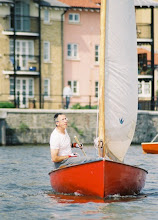


I first saw K197 when Ed brought her down to the club in Bristol Docks. I begged him for a sail but initially she did not inspire me very much. She had been converted for cruising and had lockers built in to the hull each side of the centreboard case, extending forward under the decks. The wind was light and the sail flat, so not a lot was going on.
Ed later sold her to another CVRDA member and then a few years later I saw an advert in the local paper for a Fairey Finn at a reasonable price and found it was the same boat, now owned by another CVRDA member, Lyn Gardner.
I went and had a good look. The main consideration was whether I could remove the cruising conversion and restore the boat to being a reasonable racing dinghy, which I thought I could so in October 2005 she became mine.
One of the nicest things about the boat is that she came with the original Bruder wooden mast and an original Elvstrom sail. Another Miller and Whitworth sail was also included but before racing seriously I'd need to find a Needlespar mast and a matching sail. Before the first sail I cut out the forward lockers and forward floorboards and removed fairleads and rowlock plates.
For my first sail I used the M&W sail and very quickly realised that the mast was far too upright. A Finn is supposed to sail upwind with the boom on the deck but I couldn't get the boom anywhere near. After that sail I adjusted the mast step and from then on the boat felt a lot better and was certainly faster already.
Ed told me about the early history of the boat. She was not originally sold by Fairey because she didn't measure and only some years later was she sold and modified to make her measure correctly. This was, I believe in 1964 when she became K197 (the number on the Elvstrom sail). She wasn't used much before being converted for cruising and then kept in a barn in Norfolk for a long time, from where Ed bought her in 2001.
The early sails were all about getting the very basics sorted. The mainsheet was 4:1 and much too short, so that was changed to 3:1 and a longer mainsheet bought so the boom could go out square. The toe straps were right at the sides of the cockpit so you couldn't get your feet under them, so they were moved. Both main sheet and traveller cleats, although nice original Tufnol, didn't cleat so had to be replaced. Meanwhile I was enjoying sailing the boat and beginning to get some good results in our winter series.
In January 2004 I bought a Needlespar mast and matching Musto sail (complete with British Aerospace logos as it was ex Richard Stenhouse). I then had to fit control lines and cleats as it hadn't previously had any. As the boat had a forward bulkhead in place, and knowing how well many old boats sink after a capsize I was keen to keep this so I ran all the control lines over the deck, but still using the standard purchase system. Now the boat was beginning to get sorted and starting to look and behave more like a racing Finn, at least as far as I could recall from sailing another Fairey Finn, K155 in the late 70s. And, inspired by there now being 2 classic Finns racing in our club (the other being a 1972 Mader), another member bought a Finn (a well sorted Vanguard) and we started having some very good racing.
So now I have a Finn that's got two characters. I can use the Bruder mast and Elvstrom sail and race it in CVRDA events just as it was intended in 1964. I only do this in light winds because I don't want to damage the rig. I find it's much slower upwind than other Finns with this rig but just as fast downwind. Then for regular CVRDA racing I can change to the Needlespar rig with the Musto sail, which is pretty competitive, or for club racing use a Carbospars mast with a mylar sail, which almost (but not quite) keeps up with the most modern Finns.
